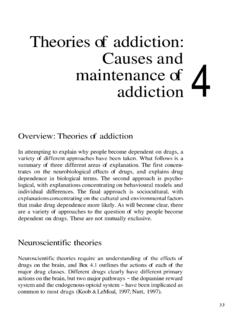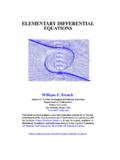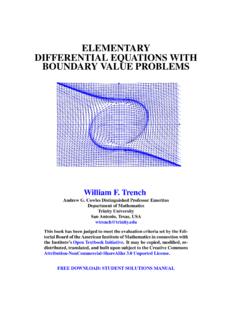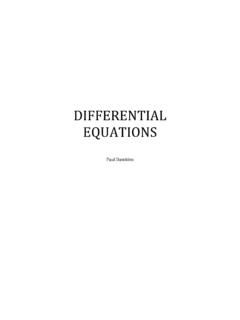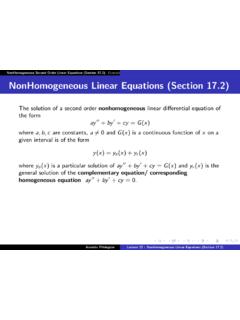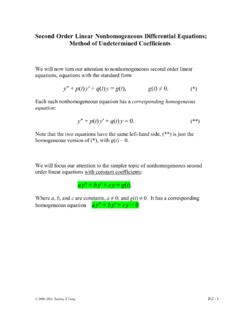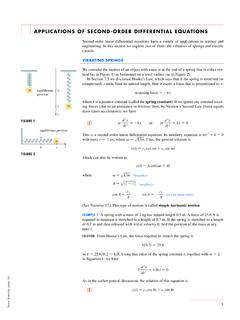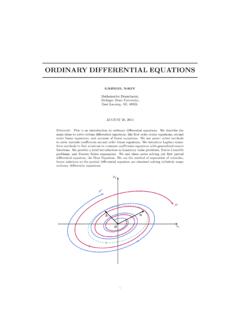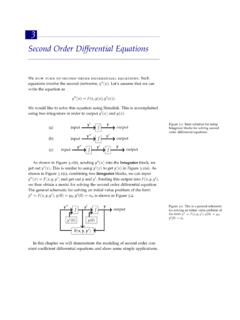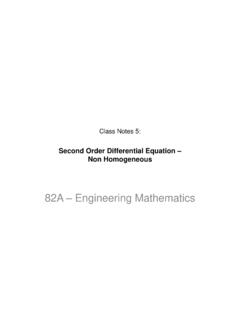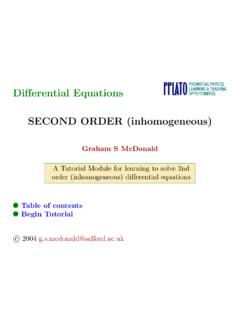Transcription of MST224 Mathematical methods - Open University
1 MST224 Mathematical methodsSecond- order differential equationsThis publication forms part of an Open University module. Details of this and otherOpen University modules can be obtained from the Student Registration and Enquiry Service, TheOpen University , PO Box 197, Milton Keynes MK7 6BJ, United Kingdom (tel. +44 (0)845 300 6090;email you may visit the Open University website where you can learnmore about the wide range of modules and packs offered at all levels by The Open purchase a selection of Open University materials visit , or contact OpenUniversity Worldwide, Walton Hall, Milton Keynes MK7 6AA, United Kingdom for a brochure(tel.))
2 +44 (0)1908 858779; fax +44 (0)1908 858787; email to readerMathematical/statistical content at the Open University is usually provided to students inprinted books, with PDFs of the same online. This format ensures that Mathematical notationis presented accurately and clearly. The PDF of this extractthus shows the content exactly asit would be seen by an Open University student. Please note that the PDF may containreferences to other parts of the module and/or to software oraudio-visual components of themodule. Regrettably Mathematical and statistical contentin PDF files is unlikely to beaccessible using a screenreader, and some OpenLearn units may have PDF files that are notsearchable.
3 You may need additional help to read these Open University , Walton Hall, Milton Keynes, MK7 published 2013 The Open UniversityAll rights reserved. No part of this publication may be reproduced,stored in a retrieval system, transmittedor utilised in any form or by any means, electronic, mechanical, photocopying, recording or otherwise, withoutwritten permission from the publisher or a licence from the CopyrightLicensing Agency Ltd. Details of suchlicences (for reprographic reproduction) may be obtained from the Copyright Licensing Agency Ltd, SaffronHouse, 6 10 Kirby Street, London EC1N 8TS (website ).Open University materials may also be made available in electronic formats for use by students of theUniversity.
4 All rights, including copyright and related rights and database rights, in electronic materials andtheir contents are owned by or licensed to The Open University , or otherwise used by The Open University aspermitted by applicable using electronic materials and their contents you agree that your use will be solely for the purposes offollowing an Open University course of study or otherwise as licensedby The Open University or its as permitted above you undertake not to copy, store in any medium (including electronic storage oruse in a website), distribute, transmit or retransmit, broadcast,modify or show in public such electronicmaterials in whole or in part without the prior written consent of The Open University or in accordance withthe Copyright, Designs and Patents Act , designed and typeset by The Open University , using the Open University TEX in the United Kingdom by Halstan & Co.
5 Ltd, Amersham, 978 1 7800 7479 preliminary Requirement for two arbitrary Linearity and superposition82 Homogeneous differential Two simple Solution in the general General procedure and further Damped harmonic oscillators223 Inhomogeneous differential General method of The method of undetermined Exceptional Combined cases404 Initial conditions and boundary Initial-value Boundary-value problems445 Resonance48 Solutions to exercises55 Acknowledgements66 Index67 IntroductionIntroductionIn this unit we move from first-orderdifferential equations to second -orderTheorderof a differentialequation is defined in Unit second - order differentialequation may or may notinclude a first equations , that is, differential equations involving a second (butno higher) derivative.
6 Examples of such equations ared2ydx2 3dydx+ 2y= 4exand 3d2ydx2+y= differential equations play a central role in the physicalsciences. They are found, for example, in laws describing mechanicalsystems, wave motion, electric currents and quantum take a simple case, consider a particle of massmthat moves in onedimension along thex-axis. At any given timet, the particle s position isx(t), and its velocity and acceleration are given by the derivativesdx/dtandd2x/dt2. There are no general laws for the position or velocity of theparticle, but there is a very important law for its acceleration:Newton sDon t worry if you have not metNewton s second law before: theessential aims of this unit do notrely on lawtells us thatmass acceleration = force,which implies thatmd2xdt2=F,(1)whereFis the force acting on the particle.
7 The force need not beconstant, and may vary with the positionxor the velocitydx/dtof theparticle. So, depending on the precise details, we get a second -orderdifferential equation forxas a function oft, and the solution of thisequation tells us how the particle can system known as asimple harmonic oscillatorprovides a goodexample. Here, a particle of massmis suspended at the lower end of aspring that is attached to a fixed support (Figure 1). The particle movesxx= 0mFFigure 1A particle ofmassmmoves along thex-axis subject to a forceFprovided by a spring andgravityup and down along a verticalx-axis, subject to a forceFprovided by thespring and gravity.
8 If the system is left to settle, the particle comes to restat a point of equilibrium, which we labelx= 0. Because the particle doesnot spontaneously move away from this position, we can inferthatF= 0whenx= the particle is displaced fromx= 0, the forceFtends to draw theparticle back towardsx= 0. We consider the case where the force isproportional to the displacement from equilibrium, and takeF= kx,(2)wherekis a positive constant. The negative sign in this equation ensuresthat the force always acts in a direction that tends to restore the particleto its equilibrium equations (1) and (2) together, we get the differential equationmd2xdt2= differential equationsRecalling thatk>0 andm >0, we can also express this asd2xdt2= 2x,(3)where = k/mis a positive constant.
9 Equation (3) is called theequation of motionof a simple harmonic oscillator. It is a second -orderdifferential equation whose solution tells us how the particle can unit develops systematic techniques to solve equations like this. Forthe moment, we will simply guess the solution and check that it know thatddt(sint) = costandddt(cost) = sint,sod2dt2(sint) = sintandd2dt2(cost) = other words, taking the second derivative of a sine or cosine functiongives the same function back again, but with a minus sign. This is veryclose to the behaviour needed to solve equation (3). We therefore try afunction of the formx(t) =Csin( t) +Dcos( t),(4)whereCandDare any constants, and is the constant in equation (3).
10 Differentiating this function once, and then again, we getdxdt=C cos( t) D sin( t),d2xdt2= C 2sin( t) D 2cos( t)= function in equation (4) does indeed satisfy equation (3). In fact, itis the general solution of this differential that our solution involves two constants,CandD, whose values arenot specified. These constants have arbitrary values, and they are calledarbitrary constants. It is typical for the general solutions of a second -orderdifferential equation to havetwoarbitrary constants. The values of theseconstants depend on how the system is released, and you will see how theyare determined later in this unit.


